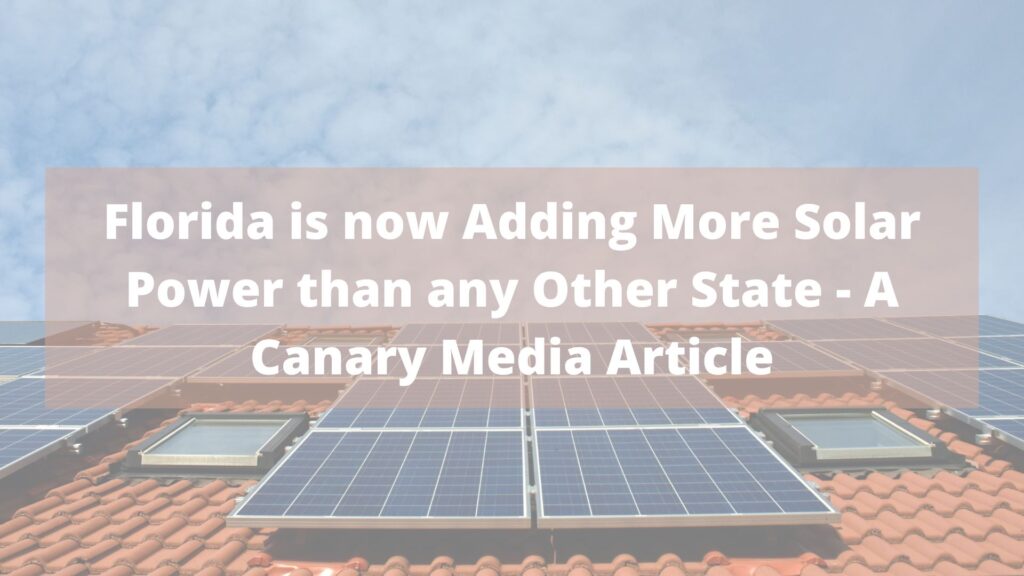
The Law Offices of John Caravella, P.C. does not own this content. This content was created by Eric Wesoff (Canary Media) and was published on September 15th, 2023. To view the full article, please click here.
The Sunshine State connected 2,499 megawatts of solar-generation capacity to the grid during the first half of 2023, blowing away the 1,648 megawatts added by California and the 1,292 megawatts added by Texas, according to the most recent U.S. Solar Market Insight report from the Solar Energy Industries Association and energy consultancy Wood Mackenzie.
It’s the first time the state has taken the No. 1 spot in solar installations, marking a potential clean energy inflection point for a populous state with a dirty grid. Florida gets just 6 percent of its electricity from solar and depends largely on fossil gas for the rest.
Florida’s solar ascendancy is the product of two familiar forces: the Inflation Reduction Act’s clean energy incentives and the stabilization of pandemic-strained supply chains. It has also occurred despite energy policies that lag behind other states. Florida doesn’t have a renewable portfolio standard and doesn’t allow power-purchase agreements — two policies that have accelerated investments in solar across the nation.
Solar policies in Florida have tended to favor utility-owned large-scale solar over residential and commercial rooftop power generation: Around 86 percent of the state’s solar installed in the first half of this year was built by utilities. The state’s largest power company, Florida Power & Light, accounted for 1,769 megawatts over that period, followed by Duke Energy, which connected 389 megawatts.
Despite the lack of a renewable portfolio standard, a ban on power-purchase agreements and the dominance of utility-scale solar, Florida does still have net metering, a policy that pays rooftop solar owners for the excess power they export to the electrical grid.
Solar-rich states such as California, Hawaii and Arizona have seen utility-led campaigns seeking to roll back net metering over the last few years. Claiming lost revenue and unfair cost shifts for their ratepayers, utilities often insist on lowering compensation rates for solar customers or adding fixed charges to customer bills.
Last year, Florida lawmakers proposed legislation that would destroy the value of net metering by imposing fixed charges and minimum bills for owners of residential solar systems.
These anti-net-metering efforts are typically supported by utilities, and that was certainly true of Florida Power & Light. Although this legislation favored by Florida utilities was passed, it was vetoed last April by Gov. Ron DeSantis (R), who ascribed his decision to concerns over inflation and escalating energy bills.
Utilities have erected obstacles to growing Florida’s residential solar such as prolonged waits for interconnection, onerous insurance requirements and institutional recalcitrance, but rooftop solar owners in the state still added 332 megawatts of solar capacity during the first half of the year, making it the No. 2 spot in the country for home PV systems.
It’s not just Florida, Texas and California surging ahead in utility-scale solar. The solar market across the whole country is forecast to add 32 gigawatts of new capacity in 2023, almost tripling the record 13 gigawatts installed in 2021 and amounting to over half of new U.S. capacity in 2023, according to the U.S. Energy Information Administration. The industry is rebounding from a difficult 2022 replete with trade conflicts, labor ethics issues and supply-chain challenges.
Thanks to this year’s surge, Florida now has a total of 12,612 megawatts of solar connected to the grid. It still has a long way to go in order to catch up with Texas’ 18,801 megawatts and California’s impressive 41,675 megawatts, but it’s moving in the right direction — even in spite of a less-than-ideal policy landscape.
John Caravella Esq., is a construction attorney and formerly practicing project architect at The Law Office of John Caravella, P.C., representing architects, engineers, contractors, subcontractors, and owners in all phases of contract preparation, litigation, and arbitration across New York and Florida. He also serves as an arbitrator to the American Arbitration Association Construction Industry Panel. Mr. Caravella can be reached by email: [email protected] or (631) 608-1346.
The information provided on this website does not, and is not intended to, constitute legal advice; instead, all information, content, and materials available on this site are for general informational purposes only. Readers of this website should contact their attorney to obtain advice with respect to any particular legal matter. No reader, user, or browser of this site should act or refrain from acting on the basis of information on this site without first seeking legal advice from counsel in the relevant jurisdiction. Only your individual attorney can provide assurances that the information contained herein – and your interpretation of it – is applicable or appropriate to your particular situation. Use of, and access to, this website or any of the links or resources contained within the site do not create an attorney-client relationship between the reader, user, or browser and website authors, contributors, contributing law firms, or committee members and their respective employers.

